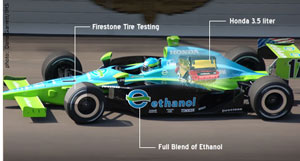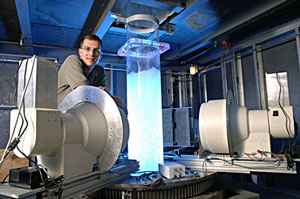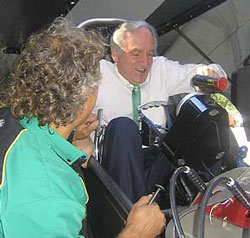 Here’s a screen shot from the home page of the Indianapolis Motor Speedway heralding the ethanol fuel test drive Monday on the track. According to an Indy release, drivers Jeff Simmons of Rahal Letterman Racing and Tony Kanaan of Andretti Green Racing drove Dallara/Honda/Firestone cars powered by ethanol and the 3.5-liter engine, the first time that package was tested at Indy.
Here’s a screen shot from the home page of the Indianapolis Motor Speedway heralding the ethanol fuel test drive Monday on the track. According to an Indy release, drivers Jeff Simmons of Rahal Letterman Racing and Tony Kanaan of Andretti Green Racing drove Dallara/Honda/Firestone cars powered by ethanol and the 3.5-liter engine, the first time that package was tested at Indy.
 Simmons, who drives the No. 17 Ethanol-sponsored car co-owned by 1986 Indianapolis 500 winner Bobby Rahal and late-night talk show legend Dave Letterman, said changes in the performance of the car, with the new fuel and engine combination, are noticeable.
Simmons, who drives the No. 17 Ethanol-sponsored car co-owned by 1986 Indianapolis 500 winner Bobby Rahal and late-night talk show legend Dave Letterman, said changes in the performance of the car, with the new fuel and engine combination, are noticeable.
“There’s a difference, and it’s all been positive so far,” Simmons said. “It’s great to be one of the guys to have the chance to run the new motor next year with the 100 percent ethanol.
Pictures and lots more information are on-line at the Indianapolis Motor Speedway site.




 Here’s a
Here’s a  Iowa State University researchers are working to cut the use of natural gas from the production of ethanol, which would make it less expensive to make since natural gas is the second largest expense in the ethanol process behind the corn.
Iowa State University researchers are working to cut the use of natural gas from the production of ethanol, which would make it less expensive to make since natural gas is the second largest expense in the ethanol process behind the corn. Iowa Senator Tom Harkin, pictured here squeezing into an ethanol-powered funny car, is calling for a study into distributing ethanol by pipeline.
Iowa Senator Tom Harkin, pictured here squeezing into an ethanol-powered funny car, is calling for a study into distributing ethanol by pipeline.
 Georgia Governor Sonny Perdue this week proposed a sales tax exemption for materials and equipment used in the construction of biofuel facilities in Georgia. According to a
Georgia Governor Sonny Perdue this week proposed a sales tax exemption for materials and equipment used in the construction of biofuel facilities in Georgia. According to a 

 The
The 
 New York lawmakers have introduced bills in Congress to provide tax credits for ethanol plants in four states which consume more than 2 percent of gasoline but make less than 2 percent of ethanol. The four states are New York, California, Florida and Texas. Small producers in these states would receive a credit of 20 cents per gallon of ethanol produced, up to 50 million gallons a year, as long as total annual production does not exceed 150 million gallons.
New York lawmakers have introduced bills in Congress to provide tax credits for ethanol plants in four states which consume more than 2 percent of gasoline but make less than 2 percent of ethanol. The four states are New York, California, Florida and Texas. Small producers in these states would receive a credit of 20 cents per gallon of ethanol produced, up to 50 million gallons a year, as long as total annual production does not exceed 150 million gallons.